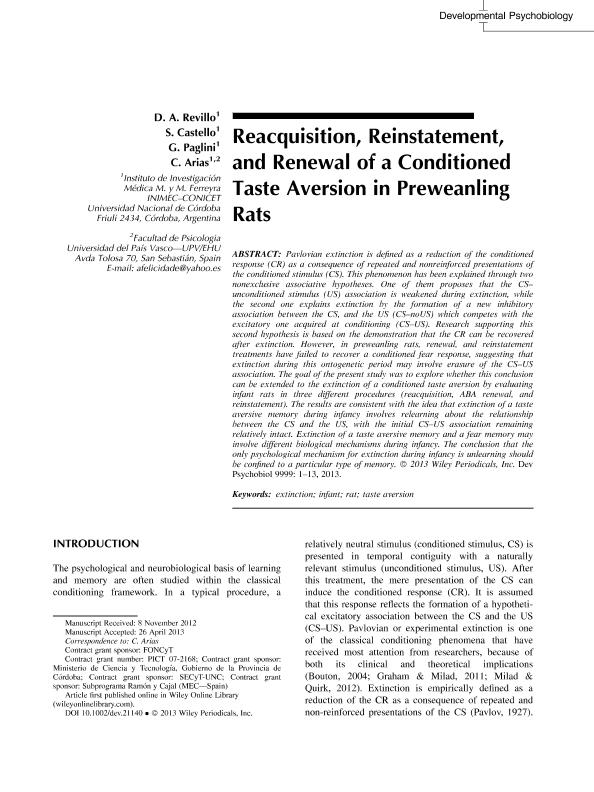Artículo
Reacquisition, reinstatement, and renewal of a conditioned taste aversion in preweanling rats
Fecha de publicación:
06/2013
Editorial:
Wiley
Revista:
Developmental Psychobiology
ISSN:
0012-1630
Idioma:
Inglés
Tipo de recurso:
Artículo publicado
Clasificación temática:
Resumen
Pavlovian extinction is defined as a reduction of the conditioned response (CR) as a consequence of repeated and nonreinforced presentations of the conditioned stimulus (CS). This phenomenon has been explained through two nonexclusive associative hypotheses. One of them proposes that the CS– unconditioned stimulus (US) association is weakened during extinction, while the second one explains extinction by the formation of a new inhibitory association between the CS, and the US (CS–noUS) which competes with the excitatory one acquired at conditioning (CS–US). Research supporting this second hypothesis is based on the demonstration that the CR can be recovered after extinction. However, in preweanling rats, renewal, and reinstatement treatments have failed to recover a conditioned fear response, suggesting that extinction during this ontogenetic period may involve erasure of the CS–US association. The goal of the present study was to explore whether this conclusion can be extended to the extinction of a conditioned taste aversion by evaluating infant rats in three different procedures (reacquisition, ABA renewal, and reinstatement). The results are consistent with the idea that extinction of a taste aversive memory during infancy involves relearning about the relationship between the CS and the US, with the initial CS–US association remaining relatively intact. Extinction of a taste aversive memory and a fear memory may involve different biological mechanisms during infancy. The conclusion that the only psychological mechanism for extinction during infancy is unlearning should be confined to a particular type of memory.
Palabras clave:
Extinction
,
Infant
,
Rat
,
Taste Aversion
Archivos asociados
Licencia
Identificadores
Colecciones
Articulos(INIMEC - CONICET)
Articulos de INSTITUTO DE INV. MEDICAS MERCEDES Y MARTIN FERREYRA
Articulos de INSTITUTO DE INV. MEDICAS MERCEDES Y MARTIN FERREYRA
Citación
Revillo, Damian Alejandro; Castelló, Stefanía Anabel; Paglini, Maria Gabriela; Arias, C.; Reacquisition, reinstatement, and renewal of a conditioned taste aversion in preweanling rats; Wiley; Developmental Psychobiology; 56; 4; 6-2013; 713-725
Compartir
Altmétricas




